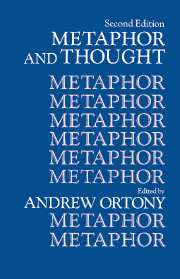Book contents
- Frontmatter
- Contents
- List of contributors
- Preface to the second edition
- Preface to the first edition
- 1 Metaphor, language, and thought
- METAPHOR AND MEANING
- 2 More about metaphor
- 3 Figurative speech and linguistics
- 4 The semantics of metaphor
- 5 Some problems with the notion of literal meanings
- 6 Metaphor
- 7 Language, concepts, and worlds: Three domains of metaphor
- 8 Observations on the pragmatics of metaphor
- METAPHOR AND REPRESENTATION
- METAPHOR AND UNDERSTANDING
- METAPHOR AND SCIENCE
- METAPHOR AND EDUCATION
- References
- Author index
- Subject index
4 - The semantics of metaphor
Published online by Cambridge University Press: 05 June 2012
- Frontmatter
- Contents
- List of contributors
- Preface to the second edition
- Preface to the first edition
- 1 Metaphor, language, and thought
- METAPHOR AND MEANING
- 2 More about metaphor
- 3 Figurative speech and linguistics
- 4 The semantics of metaphor
- 5 Some problems with the notion of literal meanings
- 6 Metaphor
- 7 Language, concepts, and worlds: Three domains of metaphor
- 8 Observations on the pragmatics of metaphor
- METAPHOR AND REPRESENTATION
- METAPHOR AND UNDERSTANDING
- METAPHOR AND SCIENCE
- METAPHOR AND EDUCATION
- References
- Author index
- Subject index
Summary
Metaphor as a feature of sentence-readings
Professor Sadock's position is that metaphor is not a linguistic problem at all, because the mechanisms underlying metaphor exist independently of language. The use of “a lion on a warrior's shield,” he says, manifests “the same analogical urge that functions in the issuance and apprehension of verbal metaphors.” But it is vital here to distinguish metaphor, on the one hand, from similes and other nonmetaphorical analogies, on the other. There is certainly no special linguistic problem about such explicitly figurative sentences as (1) or (2):
(1)He is as brave as a lion.
(2)He is like a father to her.
The linguistic problem arises instead because of implicit figuration, as in (3) or (4):
(3)He is a lion in battle.
(4)The child is father to the man.
The problem is to explain how such sentences can have the meaning they do, when they are false or nonsensical if taken literally. In other words, the analogical urge operates sometimes in literal speech, sometimes in metaphorical. It can produce both and so cannot explain the difference between the two.
My own position, as against Sadock's, is that the fundamental problem about metaphor is a problem for our theory of langue, not for our theory of parole. But I speak here only about metaphor, and not about other figures such as irony, litotes, allegory, or simile.
- Type
- Chapter
- Information
- Metaphor and Thought , pp. 58 - 70Publisher: Cambridge University PressPrint publication year: 1993
- 12
- Cited by



